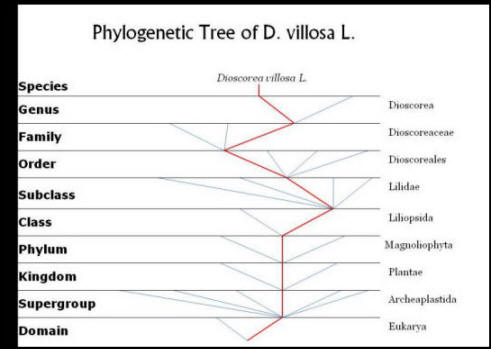Classification
 Domain
Eukarya
Domain
Eukarya
Organisms classified in the
domain Eukarya have true nuclei,
membrane-bound organelles and
linear-shaped chromosomes.
Supergroup Archaeplastida
Members of the Archaeplastida
share the ability
to
photosynthesize.
Kingdom
Plantae
The Plantae are all immobile
organisms with an
alternation of
generations.
Phylum
Magnoliophyta
These plants are both vascular and have seeds
protected by fruits. The alternation of generation
in Magnoliophyta plants are sporophyte dominated. A few other
examples of members of Magnoliophyta
that have medicinal purposes include:
Mentha piperita,
Piper nigrum, and
Digitalis Purpurea
Class
Liliopsida
Organisms within the Liliopsida
class will typically have parallel veins in leaves, the lack of
secondary growth, and floral organs in multiples of three.
Subclass
Lilidae
These plants have coenocarpous gynaecia in the
form of three or more united carpels.
Order
Dioscoreales
Members of the Dioscoreales order have
vines with net-veined leaves. They are also dioecious
(unisexual) and have axile placentation.
Family Dioscoreaceae
The plants in the Dioscoreaceae family
have twining vines that have thick rhizomes. The stems
have vascular bundles in one or two rings. Fruit in this family are
triangular and are either three-winged or flattened.
Genus
Dioscorea
Organisms
in the Dioscorea typically have steroidal sapogenins, or alkaloids.
Coats have
yellow-brown to red pigments.
The unique features of Dioscera villosa L. have adapted it for specific environments. Find out more about these habitats here.
